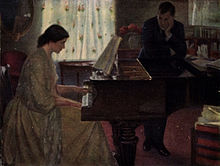Prelude
A prelude , also prelude ( Latin praeludium , foreplay) or prelude (French) and preludio (Italian and Spanish), is an instrumental work with an opening or leading character.

Originally the prelude, also known as priamel (or older: preambulum , also preambel ) was a term used from the 16th century for an introductory, free-form and improvised prelude for organ or plucked instrument ( lute , guitar , vihuela ), which was often used in the 17th century the suite opening piece and then a work for organ leading to a chorale or opening a service before it preceded it as an independent form of a fugue , a fantasy or another work (e.g. Johann Sebastian Bach , Preludes and Fugues for Organ or the two parts of the Well-Tempered Clavier ). The introductory piece of music to an opera , operetta or other musical stage piece , on the other hand, can be both a prelude (in German usage, however, called a prelude) as well as an overture or Italian symphony .
In the 19th century , the prelude for keyboard instruments developed into an independent character piece in which the original opening function was lost.
The 24 Preludes op. 28 by Frédéric Chopin are of great importance : The composer's imaginative compositional imagination ranged from short album leaves to etude-like sketches to longer pieces in three-part song form reminiscent of the Nocturnes . He arranged all pieces according to the circle of fifths with a minor parallel from C major to D minor. This cycle had a great influence on composers such as Alexander Scriabin and Sergei Rachmaninov , who also composed Preludes.
Over time, the prelude developed further - the great orchestral works Les Préludes by Franz Liszt or Prélude à l'après-midi d'un faune by Claude Debussy no longer have anything in common with the origin of a “prelude”.
See also
literature
- Markus Grassl: Prelude. In: Oesterreichisches Musiklexikon . Online edition, Vienna 2002 ff., ISBN 3-7001-3077-5 ; Print edition: Volume 4, Verlag der Österreichischen Akademie der Wissenschaften, Vienna 2005, ISBN 3-7001-3046-5 .
Web links
- Free sheet music from various preludes
- Piano sheet music: JS Bach, Prelude in C major BWV 846 (PDF; 57 kB)
- Audio sample: JS Bach, Prelude in C major BWV 846 ( Memento from September 4, 2009 in the Internet Archive ) ( MIDI ; 5 kB)
- Prelude. In: Digital dictionary of the German language . Retrieved October 13, 2019
Individual evidence
- ↑ Hans Judenkönig : That first Priamell. In: Ain beautiful artistic instruction. 1523. Cf. for example Hubert Zanoskar (ed.): Guitarrenspiel old masters. Original music from the 16th and 17th centuries. Volume 1. B. Schott's Sons, Mainz 1955 (= Edition Schott. Volume 4620), p. 12.
- ↑ Hans Judenkönig: A good preamble. In: A newgeordent artificial lute book. 1536. Cf. for example Hubert Zanoskar (ed.): Guitarrenspiel old masters. Original music from the 16th and 17th centuries. Volume 1. 1955, p. 18 f.
- ^ Konrad Ragossnig : Handbook of the guitar and lute. Schott, Mainz 1978, ISBN 3-7957-2329-9 , p. 114.
- ↑ Jerry Willard (Ed.): The complete works of Gaspar Sanz. 2 volumes. Amsco Publications, New York 2006, ISBN 0-8256-1695-6 , Volume 1, pp. 64-66 ( Preludio y Fantasia ) and pp. 72-74 ( Preludio, o Capriccho arpeado ). (Translation of the original manuscript by Marko Miletich)
- ↑ for example in Francesco Corbetta in La Guitarre Royale from 1670, Robert de Visée in Livre de Guitare from 1682 and Livre de pièces pour la Guiare from 1686, François Campion in Pièces pour la Guitarre and Ludovico Roncalli in Capricci armonici sopra la Chitarra spagnola and 1732 Santiago de Murcia in Pascalles y obras de Guitarra . See Adalbert Quadt (Ed.): Guitar music from the 16th to 18th centuries Century. 4 volumes. Edited from tablature. Deutscher Verlag für Musik, Leipzig 1970–1984, Volume 1, pp. 26–54, Volume 3, pp. 40, 46, 51, 55 and 58, and Volume 4, pp. 1, 4, 7, 10 and 14 as well 26, 30 f., 35, 39, and 42.
- ↑ Jerry Willard (Ed.): The complete works of Gaspar Sanz. 2 volumes. Amsco Publications, New York 2006, ISBN 0-8256-1695-6 , Volume 1, pp. 64-66 ( Preludio y Fantasia ). (Translation of the original manuscript by Marko Miletich)